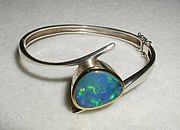Americas
Jewellery played a major role in the fate of the Americas when the Spanish established an empire to seize South American gold. Jewellery making developed in the Americas 5,000 years ago in Central and South America. Large amounts of gold was easily accessible, and the Aztecs and Mayans created numerous works in the metal. Among the Aztecs, only nobility wore gold jewellery, as it showed their rank, power and wealth. Gold jewellery was most common in the Aztec Empire and was often decorated with feathers from birds. The main purpose of Aztec jewellery was to draw attention, with richer and more powerful Aztecs wearing brighter, more expensive jewellery and clothes. Although gold was the most common and popular material used in Aztec jewellery, silver was also readily available throughout the American empires. In addition to adornment and status, the Aztecs also used jewellery in sacrifices to appease the gods. Priests also used gem encrusted daggers to perform animal and human sacrifices.
Another ancient American civilization with expertise in jewellery making was the Maya. At the peak of their civilization, the Maya were making jewellery from jade, gold, silver, bronze and copper. Maya designs were similar to those of the Aztecs, with lavish head dresses and jewellery. The Maya also traded in precious gems. However, in earlier times, the Maya had little access to metal, so made the majority of their jewellery out of bone or stone. Merchants and nobility were the only few that wore expensive jewellery in the Maya Empire, much the same as with the Aztecs.
In North America, Native Americans used shells, wood, turquoise, and soapstone, almost unavailable in South and Central America. The turquoise was used in necklaces and to be placed in earrings. Native Americans with access to oyster shells, often located in only one location in America, traded the shells with other tribes, showing the great importance of the body adornment trade in Northern America.
Pacific
Jewellery making in the Pacific started later than in other areas because of recent human settlement. Early Pacific jewellery was made of bone, wood and other natural materials, and thus has not survived. Most Pacific jewellery is worn above the waist, with headdresses, necklaces, hair pins and arm and waist belts being the most common pieces.
Jewellery in the Pacific, with the exception of Australia, is worn to be a symbol of either fertility or power. Elaborate headdresses are worn by many Pacific cultures and some, such as the inhabitants of Papua New Guinea, wear certain headresses once they have killed an enemy. Tribesman may wear boar bones through their noses.
Island jewellery is still very much primal because of the lack of communication with outside cultures; some areas of Borneo and Papua New Guinea are yet to be explored by Western nations. However, the island nations which were flooded with Western missionaries have had drastic changes made to their jewellery designs. Missionaries saw any type of tribal jewellery as a sign of the wearer's devotion to paganism. Thus many tribal designs were lost forever in the mass conversion to Christianity.

Australia is now the number one supplier of opals in the world. Opals had already been mined in Europe and South America for many years prior, but in the late 1800s, the Australian opal market became predominant. Australian opals are only mined in a few select places around the country, making it one the most profitable stones in the Pacific.
One of the few cultures to today still create their jewellery as they did many centuries prior is the New Zealand Māori, who create Hei-tiki. The reason the hei-tiki is worn is not apparent; it may either relate to ancestral connections, as Tiki was the first Māori, or fertility, as there is a strong connection between this and Tiki. Another suggestion from historians is that the Tiki is a product of the ancient belief of a god named Tiki, perhaps dating back to before the Māoris settled in New Zealand. Hei-tikis are traditionally carved by hand from bone (commonly whale), nephrite or bowenite; a lengthy and spiritual process. The Hei-tiki is now popular amongst tourists who can buy it from souvenir or jeweller shops.
Other than jewellery created through Māori influence, jewellery in New Zealand remains similar to other western civilizations; multi cultural and varied. This is more noticeable in New Zealand because of its high levels of non-European citizens.

No comments:
Post a Comment